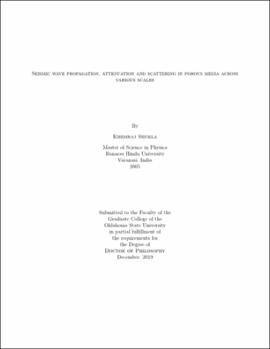| dc.contributor.advisor | Jaiswal, Priyank | |
| dc.contributor.author | Shukla, Khemraj | |
| dc.date.accessioned | 2020-06-26T21:27:55Z | |
| dc.date.available | 2020-06-26T21:27:55Z | |
| dc.date.issued | 2019-12 | |
| dc.identifier.uri | https://hdl.handle.net/11244/324877 | |
| dc.description.abstract | The theory of poroelasticity describes the mechanics of fluid saturated deformable porous solids. Poroelastic theory accurately model the seismic wave propagation in oil and gas reservoirs with an extension to other porous medium e.g. living bones and soft tissues. The poroelastic theory also incorporates the attenuation of energy caused by the relative motion between solid and fluid excited by a point source perturbation. | |
| dc.description.abstract | First and foremost, this thesis presents a comprehensive description of seismic attenuation in a viscoacoustic medium by using a fractional derivative approach. Representation of attenuation by using a fractional derivative avoids the solution of augmented system represented by memory process i.e. convolution. In this thesis, a highly accurate time integration scheme, known as rapid expansion method, with a spectral accuracy is implemented to solve the viscoacoustic wave equation. | |
| dc.description.abstract | Next, this thesis describes the implementation of a high-order weight-adjusted discontinuous Galerkin (WADG) scheme for the numerical solution of two and three-dimensional (3D) wave propagation problems in anisotropic porous media. The use of a penalty-based numerical flux avoids the diagonalization of Jacobian matrices into polarized wave constituents necessary when solving element-wise Riemann problems. | |
| dc.description.abstract | Additionally, a system of hyperbolic partial differential equations describing Biot's poroelastic wave equation for quasi-static Poisseulle and potential flow is also introduced. To incorporate effects from micro-heterogeneities due to pores, we have used the Johnson-Koplik-Dashen (JKD) model of dynamic permeability, which also account for frequency-dependent viscous dissipation caused by wave-induced pore fluids. | |
| dc.description.abstract | Next, this thesis uses a model to quantify capillary effects on velocity and attenuation. Studies that have attempted to extend Biot's poroelasticity to include capillary effects found changes in fast P-wave velocity of up to 5 % between the sonic and ultrasonic frequency ranges. | |
| dc.format | application/pdf | |
| dc.language | en_US | |
| dc.rights | Copyright is held by the author who has granted the Oklahoma State University Library the non-exclusive right to share this material in its institutional repository. Contact Digital Library Services at lib-dls@okstate.edu or 405-744-9161 for the permission policy on the use, reproduction or distribution of this material. | |
| dc.title | Seismic wave propagation, attenuation and scattering in porous media across various scales | |
| dc.contributor.committeeMember | Pashin, Jack C. | |
| dc.contributor.committeeMember | Halihan, Todd | |
| dc.contributor.committeeMember | Wang, Yanqiu | |
| osu.filename | Shukla_okstate_0664D_16480.pdf | |
| osu.accesstype | Open Access | |
| dc.type.genre | Dissertation | |
| dc.type.material | Text | |
| dc.subject.keywords | convergence | |
| dc.subject.keywords | discontinuous galerkin | |
| dc.subject.keywords | energy | |
| dc.subject.keywords | finite element method | |
| dc.subject.keywords | numerical scheme | |
| dc.subject.keywords | poroelasticity | |
| thesis.degree.discipline | Geology | |
| thesis.degree.grantor | Oklahoma State University | |
